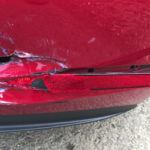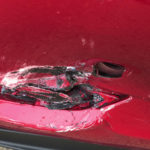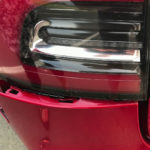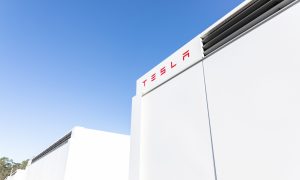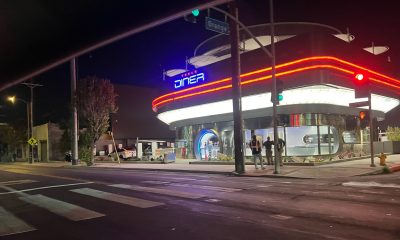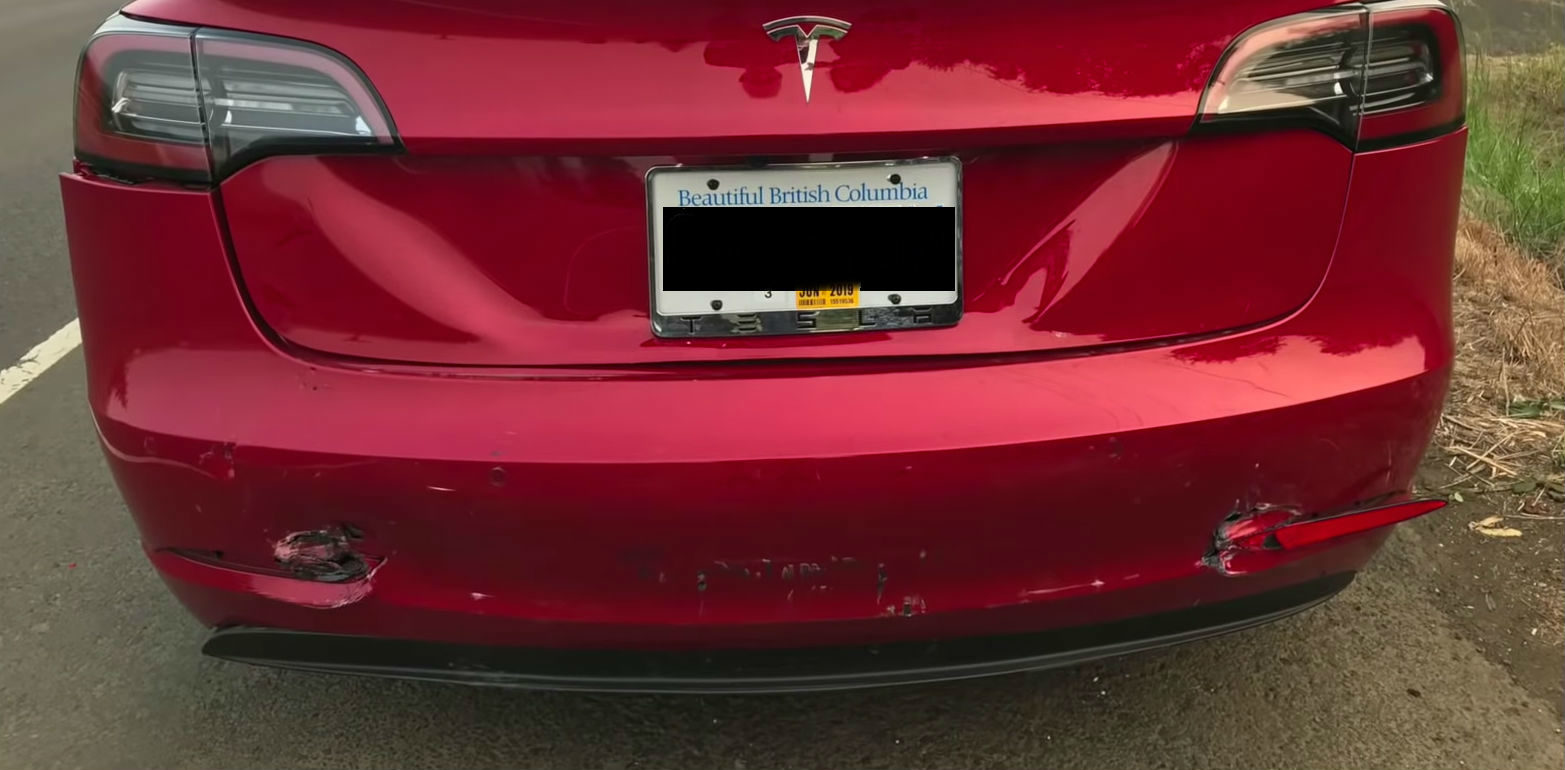

Lifestyle
Tesla shows proactive approach to passengers’ safety after Model 3 accident
Vancouver resident Peter Levey and his wife waited more than two years for their Long Range RWD Tesla Model 3. As part of their celebration for the new electric car, the couple embarked on what was supposed to be a multi-day road trip heading south to San Diego and back. Levey notes that the trip was two years in the making, and he and his wife were looking forward to it.
The first days of the road trip were everything that Peter and his spouse expected, plus more. On the first day of the trip, the couple headed to Portland, clocking in 322.3 miles on the road but only using 68 kWh of their vehicle’s 75 kWh battery, even with the A/C on during the entire trip. Unfortunately for Peter, the trip was unceremoniously cut short when a 4-door Dodge slammed into the back of their Model 3 at the intersection of Coastal Hwy 101 and Matlock Way in Oregon. The impact was notable, causing the Model 3 to get shoved 15-20 ft forward.
Authorities later informed Peter that the Dodge was likely traveling more than 40 mph when it collided with the electric sedan. The gas-powered car was significantly damaged, completely smashing its front end. Its hood was also bent at an inverted V, and its radiator was hanging out. The Model 3 showed far less damage. Multiple panels were dented, but apart from a couple of broken lights at the rear, the structural integrity of the vehicle was not compromised in any way. Peter noted in a video of the incident he uploaded on his model3man YouTube channel that even the contents of the Model 3’s trunk were unharmed by the collision.
Similar to other stories of Teslas involved in accidents, Peter’s Model 3 protected him and his wife well. They both escaped injury, and they were able to walk away from the crash without any problems. Inasmuch as this is impressive, Peter notes that what really struck him was how Tesla proactively reached out to him after the accident. For Peter, it was this approach to safety that truly made him believe how serious the company is about improving its cars and keeping its passengers secure.
“I have to say two things, and they are both about Tesla, the company, and their response to us. About a minute and a half to two minutes after the time of impact, my cellphone rang, and I looked at it, and I didn’t recognize the number — it was a 1-877. It turned out to be Tesla Roadside Assistance, and their first question was ‘Our computers show that you suffered a major impact. Are you guys okay? Were you in an accident?’ and I cannot tell you how comforting that was.
“It was just amazing. There we were — we felt alone, we felt isolated, we didn’t feel like talking to the guy behind us for obvious reasons, and there comes a call, and it’s from your car company. So we were incredibly impressed by that. And later in the afternoon, and later in the evening, Tesla Roadside Assistance worked diligently with us to try and get the car into Towing Mode, to give us everything we could try. It was most impressive.”
Tesla Roadside Assistance’s proactive response to the accident is just half of the story. A day after, Peter received yet another call from Tesla. This time, the call was from Tesla’s head of safety engineering, who asked if he and his wife were doing alright, and if he had any suggestions on how to improve the Model 3’s safety systems even more.
“The next day, when I got home from Vancouver, I got another call from the head of safety engineering, and he wanted to find out how we were. He also wanted to find out ‘What can we do to make this car safer? What can we do to give an even greater measure of safety to the occupants?’ and that was mind-blowing. I’ve never had that from any car company, and I understand why people now say the Tesla Model S, Model X, and Model 3 are the safest cars on the road.”
- Damages incurred by a Model 3 after a rear-end collision. [Credit: Peter Levey/YouTube]
- Damages incurred by a Model 3 after a rear-end collision. [Credit: Peter Levey/YouTube]
- Damages incurred by a Model 3 after a rear-end collision. [Credit: Peter Levey/YouTube]
Damages incurred by Peter Levey’s Tesla Model 3 after a rear-end collision. [Credit: model3man/YouTube]
Peter’s Model 3, whom he christened as “Red Dragon,” is currently in a Tesla-approved body shop to see if the vehicle could still be repaired. In a phone conversation with Teslarati, Peter stated that he hopes the wait for his vehicle’s repair (if it is indeed repairable) would not be too long. But even if it does take some time, he lightheartedly noted that he has a considerable amount of experience when it comes to waiting for his Model 3. Ultimately, Peter stated that he is sharing his experience not only to highlight the safety of Tesla’s vehicles. It is also about iterating how Tesla’s proactive response to its customers makes them a unique company that is both innovative and still incredibly emphatic.
“That kind of response inspires confidence among customers. They don’t abandon them when accidents happen,” he said.
Just like the Model S and Model X, the Model 3’s all-electric design does not feature a front-mounted gas-powered engine and a rear-mounted gas tank, which are found on conventional gasoline vehicles. The absence of the engine and gas tank acts as an extra large crumple zone that is capable of absorbing energy during high-speed collisions for. Apart from the ultra-high-strength steel and aluminum used for Model 3’s body structure, its floor-mounted battery pack provides further structural rigidity to the electric car. Earlier this year, the Model 3 was given a “Superior” front crash avoidance rating by the Insurance Institute for Highway Safety, which also praised the vehicle for its Forward Collision Warning and auto brake system.
Watch Peter’s YouTube video of his Model 3’s accident below.
Lifestyle
EV fans urge Tesla to acquire Unplugged Performance for edge in fleet and security industry
Unplugged Performance has built a name for itself by producing performance upgrades for Tesla vehicles.

A growing number of Tesla enthusiasts and longtime community voices are calling on the electric vehicle maker to acquire Unplugged Performance, a California-based aftermarket company best known for tuning Tesla vehicles and developing specialized government fleet solutions under its UP.FIT division.
The idea was once considered a niche proposal among EV fans, but it is now gaining serious attention not just as a performance play but as a strategic move to deepen Tesla’s roots in the fleet and security industry.
A strategic fit
Unplugged Performance has built a name for itself by producing performance upgrades for Tesla vehicles, from track-optimized components to visual and aerodynamic upgrades. But in recent years, its UP.FIT division has pivoted toward a more functional future by outfitting Tesla vehicles like Model Ys for police, military, and government use.
That work has sparked growing calls for closer collaboration with Tesla, especially as the EV maker increasingly leans into autonomy, AI, and fleet services as core components of its next chapter.
“I posted this four years ago, but I think it’s more true now than ever,” wrote Whole Mars Catalog, a well-known Tesla investor and FSD Beta tester, on X. “Tesla should buy Unplugged. But not just as a Performance division. What they are doing with UP.FIT unlocks large government and commercial fleet purchases that can improve utilization.”
Tesla fans such as shareholder Sawyer Merritt echoed the sentiment, calling Unplugged a “great fit within Tesla.” adding, “They are literally located directly next to Tesla’s design studio in Hawthorne.”
Enabling the next wave
Supporters of the idea noted that integrating Unplugged into Tesla’s corporate structure could help accelerate the adoption of autonomous technologies in government sectors. With UP.FIT patrol cars already in use across some U.S. police departments, Tesla fans envisioned a future where self-driving Teslas could potentially revolutionize law enforcement, search-and-rescue, and public service logistics.
“Just imagine how autonomous patrol cars could transform policing and bring us into a safer future,” the veteran FSD tester wrote.
The benefits could also extend to Tesla’s existing consumer base. “They also have some incredible products in the works that I think will appeal to many ordinary Tesla drivers — not just those looking for performance or mods. Stuff that’s so good it should have come straight from the design studio next door,” Whole Mars Catalog noted.
Unplugged Performance, founded in 2013, shares not just a product vision with Tesla, but also geography. Its Hawthorne headquarters sits directly adjacent to Tesla’s design studio, and the two companies have maintained a close working relationship over the years. The aftermarket firm has long positioned itself as a “mission-aligned” partner to Tesla.
In response to the recent calls for acquisition, Unplugged Performance acknowledged the support from the community. “Our very existence is to support the Tesla mission with @UpfitTesla and @UnpluggedTesla,” Unplugged CEO Ben Schaffer posted on X. “We love working with Tesla and are grateful for the community’s support since 2013!”
Elon Musk
X account with 184 followers inadvertently saves US space program amid Musk-Trump row
Needless to say, the X user has far more than 184 followers today after his level-headed feat.
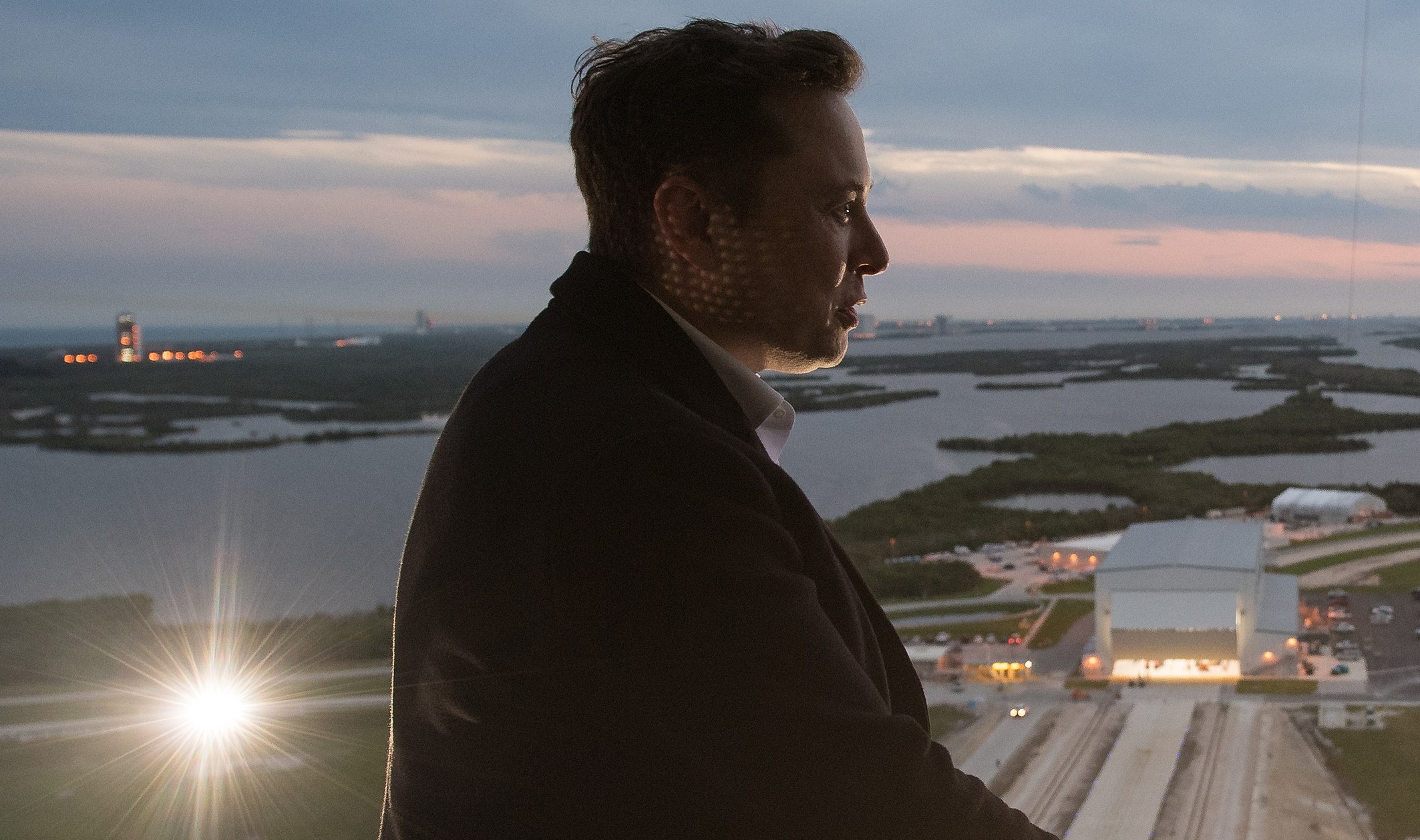
An X user with 184 followers has become the unlikely hero of the United States’ space program by effectively de-escalating a row between SpaceX CEO Elon Musk and President Donald Trump on social media.
Needless to say, the X user has far more than 184 followers today after his level-headed feat.
A Near Fall
During Elon Musk and Donald Trump’s fallout last week, the U.S. President stated in a post on Truth Social that a good way for the United States government to save money would be to terminate subsidies and contracts from the CEO’s companies. Musk responded to Trump’s post by stating that SpaceX will start decommissioning its Dragon spacecraft immediately.
Musk’s comment was received with shock among the space community, partly because the U.S. space program is currently reliant on SpaceX to send supplies and astronauts to the International Space Station (ISS). Without Dragon, the United States will likely have to utilize Russia’s Soyuz for the same services—at a significantly higher price.
X User to the Rescue
It was evident among X users that Musk’s comments about Dragon being decommissioned were posted while emotions were high. It was then no surprise that an X account with 184 followers, @Fab25june, commented on Musk’s post, urging the CEO to rethink his decision. “This is a shame this back and forth. You are both better than this. Cool off and take a step back for a couple days,” the X user wrote in a reply.
Much to the social media platform’s surprise, Musk responded to the user. Even more surprising, the CEO stated that SpaceX would not be decommissioning Dragon after all. “Good advice. Ok, we won’t decommission Dragon,” Musk wrote in a post on X.
Not Planned, But Welcomed
The X user’s comment and Musk’s response were received extremely well by social media users, many of whom noted that @Fab25june’s X comment effectively saved the U.S. space program. In a follow-up comment, the X user, who has over 9,100 followers as of writing, stated that he did not really plan on being a mediator between Musk and Trump.
“Elon Musk replied to me. Somehow, I became the accidental peace broker between two billionaires. I didn’t plan this. I was just being me. Two great minds can do wonders. Sometimes, all it takes is a breather. Grateful for every like, DM, and new follow. Life’s weird. The internet’s weirder. Let’s ride. (Manifesting peace… and maybe a Model Y.)” the X user wrote.
Lifestyle
Tesla Cybertruck takes a bump from epic failing Dodge Charger
The Cybertruck seemed unharmed by the charging Charger.
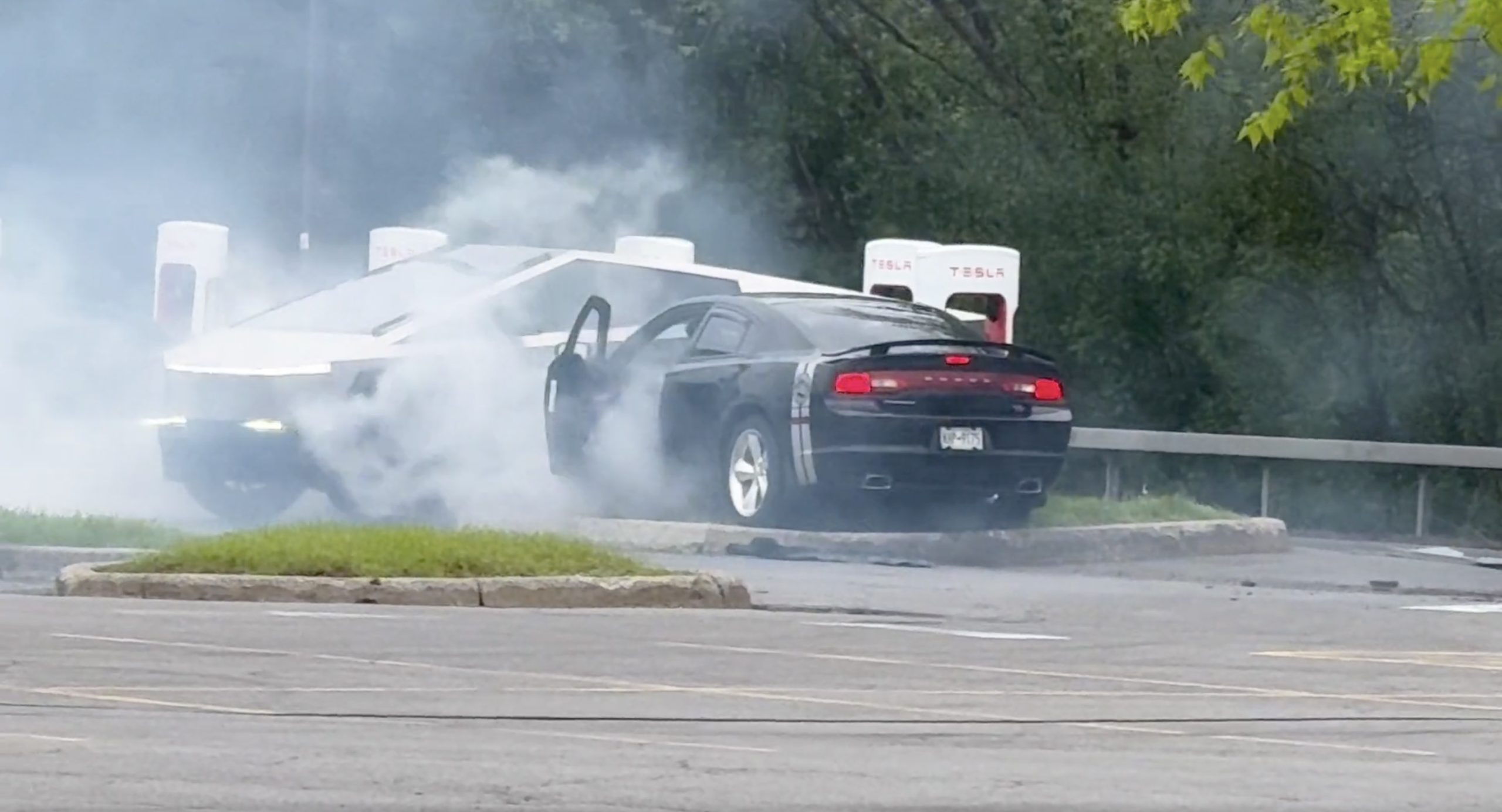
There comes a time in a driver’s life when one is faced with one’s limitations. For the driver of a Dodge Charger, this time came when he lost control and crashed into a Tesla Cybertruck–an absolute epic fail.
A video of the rather unfortunate incident was shared on the r/TeslaLounge subreddit.
Charging Charger Fails
As could be seen in the video, which was posted on the subreddit by Model Y owner u/Hammer_of_something, a group of teens in a Dodge Charger decided to do some burnouts at a Tesla Supercharger. Unfortunately, the driver of the Charger failed in his burnout or donut attempt, resulting in the mopar sedan going over a curb and bumping a charging Cybertruck.
Ironically, the Dodge Charger seemed to have been parked at a Supercharger stall before its driver decided to perform the failed stunt. This suggests that the vehicle was likely ICE-ing a charging stall before it had its epic fail moment. Amusingly enough, the subreddit member noted that the Cybertruck did not seem like it took any damage at all despite its bump. The Charger, however, seemed like it ran into some trouble after crashing into the truck.
Alleged Aftermath
As per the the r/TeslaLounge subreddit member, the Cybertruck owner came rushing out to his vehicle after the Dodge Charger crashed into it. The Model Y owner then sent over the full video of the incident, which clearly showed the Charger attempting a burnout, failing, and bumping into the Cybertruck. The Cybertruck owner likely appreciated the video, in part because it showed the driver of the Dodge Charger absolutely freaking out after the incident.
The Cybertruck is not an impregnable vehicle, but it can take bumps pretty well thanks to its thick stainless steel body. Based on this video, it appears that the Cybertruck can even take bumps from a charging Charger, all while chilling and charging at a Supercharger. As for the teens in the Dodge, they likely had to provide a long explanation to authorities after the incident, since the cops were called to the location.
-

 Elon Musk2 weeks ago
Elon Musk2 weeks agoTesla investors will be shocked by Jim Cramer’s latest assessment
-

 News2 days ago
News2 days agoTesla debuts hands-free Grok AI with update 2025.26: What you need to know
-

 Elon Musk4 days ago
Elon Musk4 days agoxAI launches Grok 4 with new $300/month SuperGrok Heavy subscription
-

 Elon Musk7 days ago
Elon Musk7 days agoElon Musk confirms Grok 4 launch on July 9 with livestream event
-

 News2 weeks ago
News2 weeks agoTesla Model 3 ranks as the safest new car in Europe for 2025, per Euro NCAP tests
-

 Elon Musk2 weeks ago
Elon Musk2 weeks agoxAI’s Memphis data center receives air permit despite community criticism
-

 News4 days ago
News4 days agoTesla begins Robotaxi certification push in Arizona: report
-

 News2 weeks ago
News2 weeks agoTesla sees explosive sales growth in UK, Spain, and Netherlands in June

